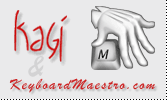A Macro is executed when any of its Macro Triggers is activated. There are many triggers to choose from (detailed below), the most common being a Hot key, that is a Macro is executed in response to a key press, usually in conjunction with one or more modifier keys. You can also create a floating palette of macros, execute macros in response to applications launching or quitting, or continuously while they are running, execute macros using a PowerMate, or at a particular time of day, as well as other possible events.
There are many Macro Triggers available for your use.
The most common Macro Trigger is the traditional Hot Key. You execute a Macro by pressing a key combination - a keyboard key like a letter, number, symbol or function key in combination with one or more modifiers (Shift, Control, Option and/or Command). Except for function keys, you must specify at least one modifier. Normally the Macro will not repeat if you hold the key down, but you can enable Key Repeat to have the macro execute continuously while you hold they key combination down.
A common use for Hot Key triggers is to open applications or documents, insert text templates, or as a way of remapping command keys (for instance you can make command-T execute “Replace and Find Again” in an application that uses a different command key (or no command key) for that menu command).
You can have a Macro execute in response to an application event, such as when the specified application launches, quits, activates or deactivates. You can also have the Macro run periodically while an application is running or while it is at the front.
You could use a trigger like this to simulate workspaces by automatically setting up an application the way you want when you launch it, or you could clean up after an application when you quit.
You can use the Time trigger to execute a macro when you login or at a specific time. You can also execute a macro periodically (for example every ten minutes or every three days). Time triggers can also be restricted to certain days of the week.
You could use a trigger like this to set up your Mac environment before arriving at work, run periodic maintenance or backup scrips late on the weekend, or launch iChat for your weekly video conference.
You can have a macro execute when you click on it in a floating Macro Palette. Keyboard Maestro will only display the palette when there are active Macros, so if your Macros are restricted to particular applications, then the Macro Palette will only appear in those applications.
You could use a trigger like this to add an action palette to an application that does not have such a facility.
You can have a macro execute when you use a PowerMate, clicking or turning the knob, optionally in conjunction with a modifier key. If you have a PowerMate, this is a way of letting it access all the power of Keyboard Maestro.

Conduct your Mac Like a Pro!